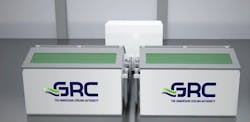Cabling best practices with immersion cooling
By Curt Wallace, Green Revolution Cooling
Cabling is a key part of the infrastructure of any data center and managing the miles of cable in the average center is always a significant task. Racks and cable ties and color-coding schemes enable your team to effectively and efficiently manage these essential connectors, securing and routing cabling and identifying and easily swapping out cables when necessary. Data centers that use liquid immersion cooling use cables to connect computing equipment, too. Exactly how do data center owners and operators manage their cabling when their servers are immersed in liquid coolant?
Immersion cooling manufacturers understand the need for cable management when designing their cooling racks. Because the servers themselves are completely immersed, the cable connections are also made under the surface of the coolant. While the liquid used to cool sensitive IT equipment is non-conductive and non-flammable, it can damage certain types of cabling. Some PVC cable jackets stiffen over time from being immersed in the liquid coolant. Data center operators may choose to continue to use low-cost cabling with PVC jackets, like Ethernet cables, and simply swap them out when they stiffen. Otherwise, it’s best to use cables with synthetic rubber cladding, which the liquid coolant does not affect.
Some immersion cooling manufacturers build racks with features to ensure the safety of the cables and to facilitate better cable management for data center operators. They include dedicated locations for components like power distribution units (PDU) and switches, and make immersion cooling racks that can accommodate any brands or styles of servers and hardware, fitting most configurations.
Because they don't know in advance the kinds of hardware customers will use, immersion cooling manufacturers ensure that data centers using their equipment will be able to adhere to best practices for cable installations. These include custom cable lengths to avoid the dangers of loose cables, color coding to easily identify the types of cables or connections, and labeling on both ends of each cable to ensure they are easily identifiable during installation or repair. When manufacturers provide the immersion racks, servers, and hardware, they can design the system with appropriately routed and labeled cables already installed.
Immersion cooling does add an extra layer of complexity for cabling. Yet, data centers using this type of cooling don’t need to worry about where to put their cables or how to manage them. Some manufacturers anticipate these issues and enable successful implementation with racks to accommodate and control all the necessary cabling and cables designed to work while immersed in coolant. Customers so inclined to make their data center racks and cables orderly and pristine will find the tools to do so built right into their immersion cooling racks.
Curt Wallace is senior solutions architect with Green Revolution Cooling (GRC).
